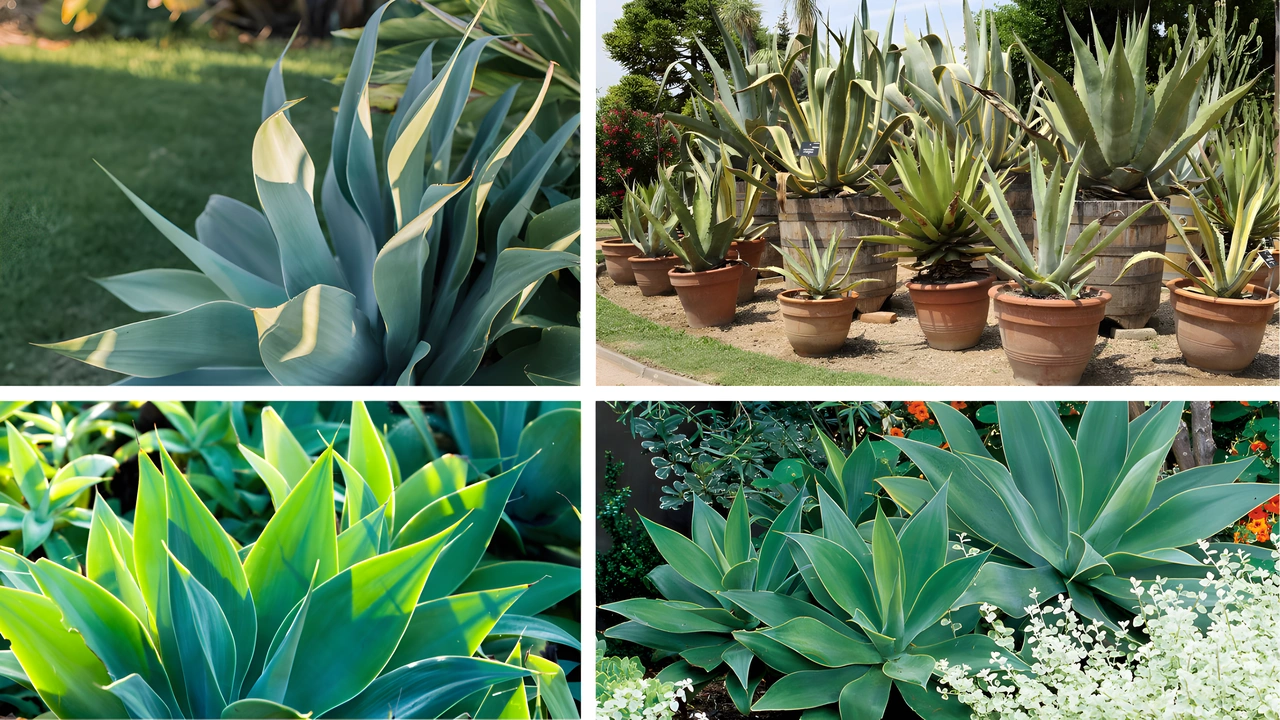Join on WhatsApp
Get the latest updates directly on WhatsApp – motivation, news & more!
Agave plants are striking, low-maintenance succulents that bring a touch of desert elegance to any garden or container setup. Whether you’re a seasoned gardener or a first-time plant owner, understanding how to grow and care for agave plants is essential to ensure they thrive. These architectural beauties are known for their rosette-shaped leaves, drought tolerance, and unique textures. In this complete guide to thriving succulents in gardens and containers, we’ll explore everything you need to know to successfully grow and care for agave plants—from choosing the right variety to long-term maintenance.

Understanding Agave Plants Before You Grow and Care for Them
Before you begin to grow and care for agave plants, it’s important to understand their origin and growth habits. Agaves are native to arid and semi-arid regions of the Americas, particularly Mexico and the southwestern United States. Known for their slow growth and impressive lifespan, some species live for decades before flowering once and dying—a process called monocarpic blooming.
When preparing to grow agave plants, you need to recognize their need for full sun, minimal water, and well-draining soil. Whether planted in gardens or containers, agave plants prefer tough love over pampering. Their thick, fleshy leaves are designed to retain moisture, making them perfect for drought-prone regions and low-maintenance landscaping.
Choosing the Right Variety to Grow and Care for Agave Plants
Not all agave plants are the same. There are over 200 species, and selecting the right one is crucial for success in growing and caring for agave plants. Some varieties grow massive and are better suited for open landscapes, while others are compact and ideal for containers.
Here are a few popular types to consider:
| Agave Variety | Ideal For | Mature Size | Growth Habit |
|---|---|---|---|
| Agave americana | Large garden landscapes | Up to 6 ft tall/wide | Spreading and dramatic |
| Agave parryi | Small gardens and containers | 1.5–2.5 ft wide | Dense and compact |
| Agave attenuata | Decorative containers or borders | 4–5 ft tall | Curved, soft-leaf rosettes |
| Agave victoriae-reginae | Indoor pots and rock gardens | 1–2 ft wide | Symmetrical and slow-growing |
| Agave desmettiana | Modern containers or patios | 3–4 ft tall | Smooth and arching leaves |
Choosing the right type will determine how much space, sunlight, and long-term care your agave plant will need. Knowing this is a vital step in learning how to grow and care for agave plants successfully.
Soil and Sunlight: Key Ingredients to Grow and Care for Agave Plants
When planning to grow and care for agave plants, the importance of soil and sunlight cannot be overstated. Agaves require well-draining soil to prevent root rot, which is one of the most common causes of agave failure. For container setups, use a cactus or succulent mix combined with sand or pumice for optimal drainage. In garden beds, amending heavy clay with gravel or perlite is essential.
Sunlight is equally important. Agaves thrive in full sun—at least 6 to 8 hours daily. For container-grown agave plants, place the pots in bright locations such as south-facing patios or balconies. In extremely hot climates, some afternoon shade can help prevent leaf scorching.
In both gardens and containers, replicating the agave’s natural desert habitat will help you grow and care for agave plants more effectively.
Watering and Fertilization: Balanced Care for Thriving Agave Plants
While agaves are drought-tolerant, they still need some moisture—especially during their early growth stages. To grow and care for agave plants correctly, you must strike the right balance between underwatering and overwatering.
Watering Tips:
- Young plants: Water once every 7–10 days during the first summer after planting.
- Mature plants: Water every 2–3 weeks during hot, dry weather. Reduce watering in fall and stop almost entirely in winter.
- Containers: Ensure the pot drains thoroughly after each watering. Never allow water to sit in the saucer.
Fertilization is rarely required, but if you want to encourage growth, a diluted, balanced fertilizer applied once in early spring can be beneficial. Overfeeding can cause agaves to grow unnaturally fast, making them leggy and less resilient. Keeping things minimal is a golden rule when you grow and care for agave plants.
Planting Techniques to Grow and Care for Agave Plants in Containers and Gardens
To successfully grow and care for agave plants, proper planting techniques must be followed from the beginning. Whether you’re placing them in the garden or a decorative container, correct placement and preparation ensure long-term success.
Planting in Gardens:
- Choose a sunny, elevated spot to promote drainage.
- Dig a shallow hole just big enough for the root ball.
- Backfill with sandy soil, gently firming it around the base.
- Do not bury the crown, as this invites rot.
Planting in Containers:
- Select a container with drainage holes.
- Use a succulent/cactus soil mix.
- Position the agave with the crown slightly above the soil line.
- Avoid overwatering, especially in humid environments.
Agave plants in containers should be rotated every few weeks for even sun exposure. Garden agaves benefit from gravel mulch to reduce moisture around the base. No matter where you plant, using the right techniques is essential when learning how to grow and care for agave plants properly.
Pests, Diseases, and Prevention When You Grow and Care for Agave Plants
Though generally resilient, agave plants can still face issues from pests and diseases. Vigilance is key when you grow and care for agave plants, especially in humid or rainy climates.
Common Issues:
- Agave snout weevil: This insect bores into the base, causing collapse. Use preventive insecticides in spring.
- Root rot: Caused by poor drainage or overwatering. Always ensure proper soil and spacing.
- Leaf spots: Fungal infections can appear if plants are overcrowded. Space plants well and water at the base.
Regular inspection, especially in the growing season, is important. Remove dead or damaged leaves promptly and keep your agave setup clean. Prevention is easier than cure when you grow and care for agave plants.
Winter Protection and Seasonal Tips to Grow and Care for Agave Plants Year-Round
Agave plants may be desert natives, but many species are surprisingly frost-tolerant. However, prolonged cold or wet conditions can damage or kill them. When you grow and care for agave plants year-round, especially outside their native climate, seasonal planning is vital.
Tips for Cold Climates:
- Use cold-hardy varieties like Agave parryi or Agave montana.
- Cover garden agaves with frost cloth on freezing nights.
- Move container agaves indoors or into sheltered areas during winter.
- Avoid watering during winter, as soggy soil combined with freezing temps leads to root damage.
Even in warmer climates, occasional maintenance like removing fallen leaves and debris will keep your agave plants thriving. Following seasonal practices helps ensure your ability to grow and care for agave plants doesn’t stop with the changing weather.
Propagation: Multiply Your Success as You Grow and Care for Agave Plants
Once you’ve successfully grown one agave, why stop there? Agave plants produce pups, or offsets, which can be removed and replanted. Propagation is a satisfying part of the process when you grow and care for agave plants long-term.
How to Propagate:
- Wait until the pup is at least 1/3 the size of the parent plant.
- Gently dig around the base and separate it with a clean, sharp knife.
- Let the pup dry for 24–48 hours to callous.
- Replant in well-draining soil and water lightly.
Propagation not only expands your garden but also gives you backup plants in case of disease or aging. It’s a great way to share your love for agaves with others who also want to grow and care for agave plants.
Conclusion: How to Grow and Care for Agave Plants for Long-Term Success
Growing and caring for agave plants is a fulfilling experience for gardeners who appreciate hardy, low-maintenance beauty. From selecting the right species to mastering soil, sun, and watering needs, this complete guide equips you with everything you need to help your agave plants thrive in both gardens and containers. These sculptural succulents are ideal for beginners and experts alike, offering minimal fuss for maximum reward. Whether you live in a dry desert or a temperate suburb, learning how to grow and care for agave plants ensures long-term success and satisfaction. Embrace the natural elegance of agave, and enjoy the ease and endurance they bring to your green space.


